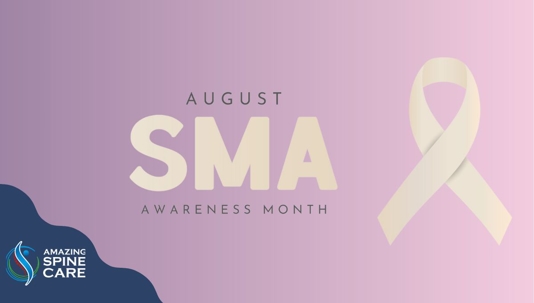Understanding This Condition and How to Manage Symptoms
August is Spinal Muscular Atrophy Awareness Month. At Amazing Spine Care, we want to bring attention to this condition and help our patients understand how to manage symptoms with chiropractic care.
What is Spinal Muscular Atrophy?
Spinal muscular atrophy (SMA) is a neuromuscular disorder that results in the loss of motor neurons and progressive muscle weakness. SMA is caused by a mutation in the survival motor neuron 1 (SMN1) gene. This gene provides instructions for making a protein critical for the function of motor neurons.
Types of SMA
The loss of motor neurons leads to muscle weakness and atrophy. SMA is classified into four types based on the age of onset and severity of symptoms:
Type I
Also called Werdnig-Hoffmann disease, it is the most severe form of SMA. Symptoms typically appear before six months of age and may include poor muscle tone, weak muscles, difficulty feeding, and respiratory problems.
Type II
Referred to as intermediate SMA, it is less severe than type I. Symptoms typically appear between six and 18 months of age and may include poor muscle tone, weak muscles, and delayed motor milestones.
Type III
Also called Kugelberg-Welander disease, it is the least severe form of SMA. Symptoms typically appear after 18 months of age and may include mild muscle weakness and delays in motor milestones.
Type IV
Symptoms of type IV SMA are typically mild and may not be noticeable until later in adulthood.
How is SMA Diagnosed?
SMA is diagnosed through a combination of clinical examination, medical history, family history, and genetic testing. A physical exam will be conducted to assess muscle strength and reflexes. The doctor will also ask about any family history of SMA or other neuromuscular disorders.
Genetic testing is often used to confirm a diagnosis of SMA. This test looks for the presence of mutations in the SMN1 gene.
How is SMA Treated?
There is no cure for SMA, but treatments are available to help manage symptoms and improve quality of life. Physical therapy, occupational therapy, and speech therapy can help maintain muscle strength and function. Orthopedic interventions such as braces or wheelchairs may be recommended to support mobility.
Nutritional counseling can also help manage SMA. A dietitian can work with you to ensure you get the nutrients you need to maintain your health.
Chiropractic care is also an essential part of SMA management. Chiropractors can help relieve pain, improve range of motion, and reduce muscle spasms. Regular chiropractic adjustments can also help prevent further decline in muscle function.
Complete Care for Your Spinal Health
If you or a loved one has been diagnosed with SMA, the team at Amazing Spine Care is here to help. We offer a wide range of services to support your spinal health, including chiropractic care, physical therapy, and more. Please contact us today to schedule an appointment.

